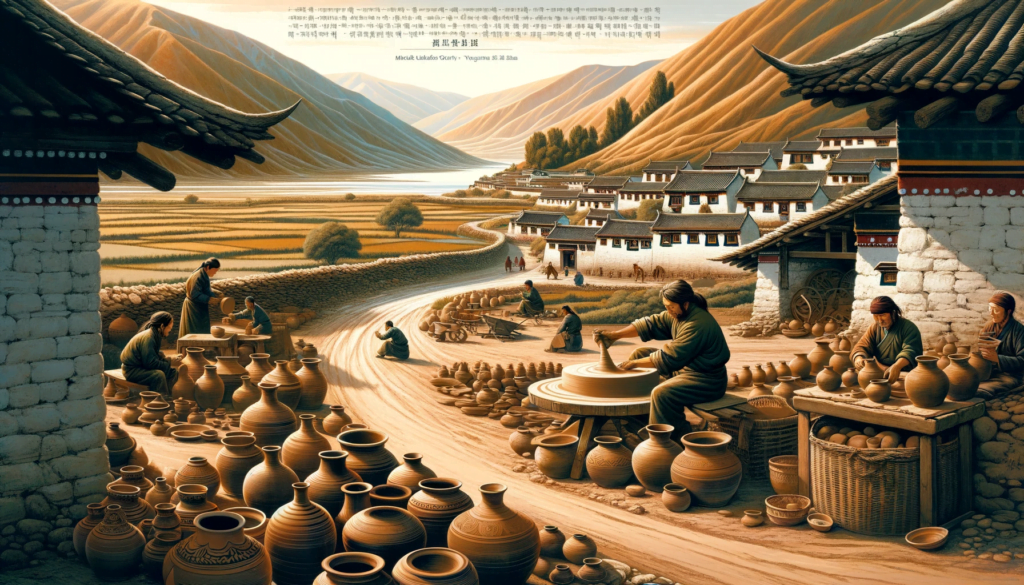Discover Taba Village in Meldro Gungkar County, Lhasa, a quaint agricultural hamlet nestled along the Lhasa River Valley on the golden travel route to Nyingchi on National Highway 318. Home to around twenty families, most of whom sustain themselves through pottery, Taba has a rich heritage known throughout history for its pottery-making fame.
The Legacy of Taba Pottery:
- Historic Pottery Village: Just a kilometre past the town centre of Meldro Gungkar County, Taba Village stretches along the highway, historically celebrated for its pottery. Travellers can spot heaps of red clay soil along the roadside – remnants of generations of pottery craftsmanship and a symbol of Taba’s place in the national and autonomous region’s intangible cultural heritage.
- Ancient Tibetan Ceramics: With a history of around 5,000 years, Tibetan pottery dates back to the Neolithic age. Like their counterparts in Central China and other parts of the world, Tibetan ancestors discovered the transformational magic of fire and clay. They crafted pottery using techniques like coiling and pinching, making vessels for water and cooking, thereby revolutionizing food and drink preparation.
The Craftsmen of Taba:
Pottery in Taba Village has a history spanning a millennium. Before Tibet’s peaceful liberation, the old Tibetan government, Lhasa nobility, and monasteries commissioned pottery from Taba, granting the village a status akin to the official kilns of ancient mainland China. However, the old Tibetan aristocracy did not indulge in fine ceramics as passionately as their mainland counterparts.
The Social Standing of Taba Potters:
Regulated by written or unwritten laws, the old Tibetan government provided Taba’s potters with tax and labour concessions. In old Tibet, potters, along with blacksmiths and sky burial masters, were considered part of the lowest social class, with marriages restricted to similar social standings. Potters carried their tea bowls to avoid sharing drinks with commoners, officials, and monks, a social norm that placed them at the bottom of the hierarchy.
Taba’s Pottery Today:
The village’s pottery tradition remains alive, with new layers of fired clay continuously added to the heaps. Taba’s method, unchanged for thousands of years, involves open-air firing rather than kiln baking, leaving a lasting impression on those who pass through the village.

Taba Village: Preserving the Art of Tibetan Pottery in Modern Times
In the picturesque settings of Taba Village, located in Meldro Gungkar County near Lhasa, lies a small but significant community known for its long-standing tradition of pottery-making. Taba, situated along the scenic route of National Highway 318 between Lhasa and Nyingchi, is a village that has carved out a name for itself in the history of Tibetan ceramics.
The Tradition of Taba Pottery:
Taba’s pottery legacy is evident in the mounds of red and white clay outside the village, revealing the artistic marks left by generations of potters. These remnants of the past stand as markers of Taba’s contribution to Tibet’s national and regional intangible cultural heritage.
The Ancient Craft of Tibetan Ceramics:
Tibetan pottery has a venerable history spanning 5,000 years. In the Neolithic era, Tibetans discovered the transformative power of fire and clay, much like their contemporaries in other parts of the world. They experimented with techniques such as coiling and pinching to create vessels for carrying and cooking food, which became integral to their cuisine.
The Pottery Process in Taba:
The process begins with sourcing red and white clay from nearby hillsides. After crushing and sieving the clay and mixing it with quartz or mica sand, the potters use hand-operated wheels to shape the vessels. Finished clay pots are left to dry before being stacked and fired using an open-air method fueled by grassroots and cow dung.
The Socioeconomic Role of Pottery in Taba:
Despite their craftsmanship, Taba’s potters were historically regarded as one of the lowest social classes in old Tibetan society, with restrictions on their social interactions and marriages. Today, they balance farming with pottery, crafting in their spare time and selling their wares in nearby towns or bartering for essential goods.
The Decline and Resurgence of Pottery:
With the advent of modern materials like steel, aluminium, and plastic, traditional pottery saw a decline. However, Taba Village is a beacon of cultural preservation, where the ancient art of pottery continues to be practised and cherished.
The Renaissance of Traditional Pottery: Embracing Eco-Friendly Practices in Modern Times
In the age where plastic and stainless steel have dominated the market for decades, traditional pottery is experiencing a resurgence. Recognized for its environmental benefits and capacity to preserve the original flavours of food, pottery is becoming the preferred choice for many.
The Eco-Friendly Appeal of Pottery:
Traditional pottery, free from chemical contamination and disease-causing residue, maintains the authentic taste of foods, from the sweetness of barley wine to the creamy aroma of butter tea. Its thermal insulation properties aid in energy conservation and reduce environmental pollution.
Nostalgia and Modern Use:
A wave of nostalgia has brought back the pottery of our ancestors, gradually replacing or reducing the use of plastic and metal utensils. Collectors now treasure vintage pottery as artistic pieces, adding a touch of traditional elegance to modern living spaces and showcasing the historical and cultural significance of the craft.
The Market Transformation:
Once-discarded pottery has found its way into antique markets, fetching high prices from collectors and entering the art market. This renewed interest has prompted calls for governmental action to preserve this nearly lost art, protect cultural heritage, and support its production.
Cultural Enterprises and Craft Revival:
Cultural companies and craft stores are discreetly venturing into pottery villages to explore and assist in refining the craft. By redesigning traditional utilitarian items into modern crafts with a strong ethnic character, these enterprises are introducing Tibetan pottery to the tourism and international markets, shining new light on the ancient art of fire and clay.
